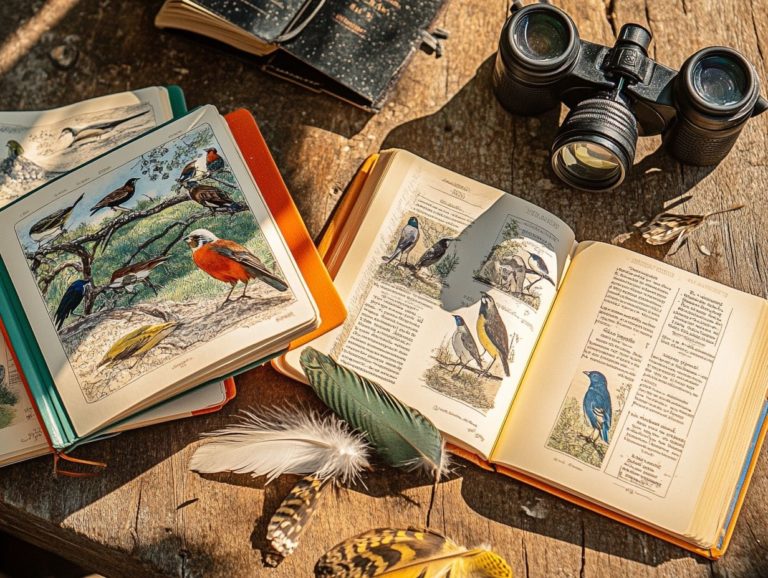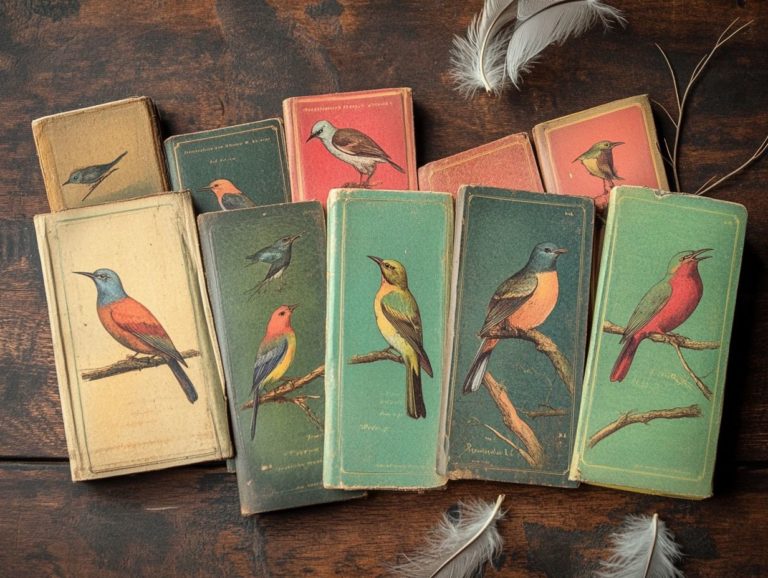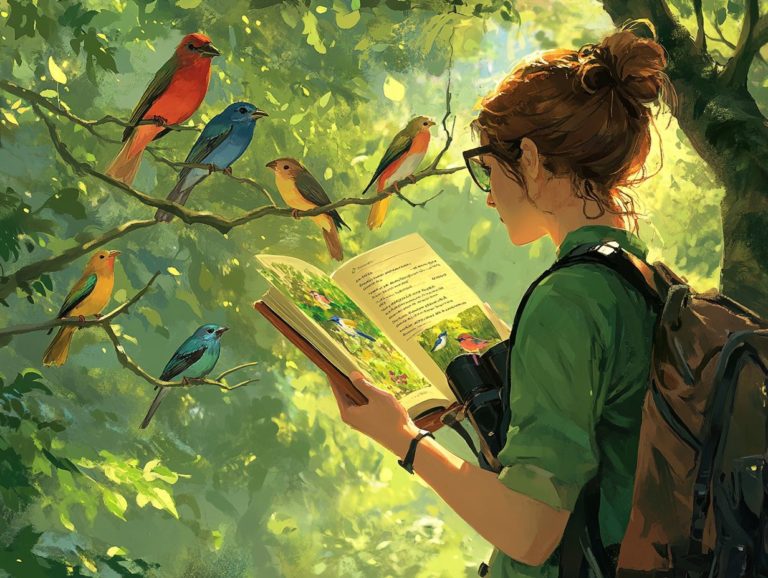The Future of Bird Field Guides in Digital Age
The world of birding is undergoing a remarkable transformation as technology redefines how you connect with nature.
With the rise of digital field guides and innovative apps, bird watchers now have an abundance of resources at their fingertips, making the pursuit of bird species knowledge more accessible than ever.
This article delves into the history and evolution of bird field guides, weighing the pros and cons of digital formats while examining current trends in the realm of digital birding.
You’ll also discover emerging technologies that promise to enhance your birding experience in exciting new ways.
Join us as we dive into the thrilling world where nature meets technology!
Contents
- Key Takeaways:
- The Impact of the Digital Age on Bird Field Guides
- Current Trends in Digital Birding
- Predictions for the Future of Bird Field Guides
- How Digital Guides Can Enhance Birding Experience
- Frequently Asked Questions
- What are bird field guides?
- How have bird field guides evolved in the digital age?
- What are the advantages of using digital bird field guides?
- Are traditional paper bird field guides becoming obsolete?
- How can digital bird field guides benefit conservation efforts?
- Are there any downsides to using digital bird field guides?
Key Takeaways:

- Digital bird field guides are user-friendly and convenient, but they come with limitations.
- Digital birding has revolutionized how birders identify and learn about birds through apps and platforms.
- The future of bird field guides will likely see advancements in technology, such as augmented reality and artificial intelligence, to enhance the birding experience.
History and Evolution
The history and evolution of birding and field guides can be traced back to the remarkable contributions of early American ornithologists like Roger Tory Peterson and Richard Crossley. These individuals meticulously documented the diverse bird species of America, setting a standard for future generations of birders.
They immersed themselves in understanding the nuances of bird feathers and identifying individual species, laying the groundwork for the comprehensive guides you rely on today.
These pioneers employed innovative methodologies, often utilizing sketches and detailed notes to capture their observations, which ultimately transformed into the field guides cherished by enthusiasts like you.
As time went on, the advent of digital photography revolutionized how birders engage with their passion, enabling you to document and share sightings with impressive accuracy across various platforms.
Apps and technology have advanced greatly, broadening accessibility to birdwatching. As a result, the birding community has flourished, welcoming a new generation eager to explore avian life equipped with tools that their predecessors could only dream about.
The Impact of the Digital Age on Bird Field Guides
The digital age has truly transformed bird field guides, redefining how you engage with your surroundings. With cutting-edge technologies like smartphone apps, artificial intelligence, and augmented reality at your fingertips, exploring the future of bird watching apps has never been easier or more immersive.
This evolution has opened up a vibrant world for birders, granting you access to a wealth of user-generated content and comprehensive guides that were once beyond reach.
Advantages and Disadvantages of Digital Guides
Digital guides offer a wealth of benefits, such as stunning visual representations of wild birds and access to rich soundscapes of their songs. For those looking for comprehensive resources, exploring the top 10 bird guides available online can enhance your experience. However, they also come with their own set of challenges, like dependence on technology and the risk of information overload.
For you, as a birdwatcher, these digital platforms are available anytime, anywhere, significantly enhancing your field experience. Interactive maps enable you to locate specific species in their habitats, making your birdwatching adventures more engaging and educational.
But remember, this convenience comes with a caveat: a reliance on smartphones or tablets, which might decide to fail you in those remote areas.
While user-generated content can offer vibrant insights, it may also lead to misinformation if not properly vetted. Therefore, as you explore these modern resources, it s essential to approach them with a critical eye and verify facts to ensure you re gaining accurate knowledge.
Current Trends in Digital Birding

Current trends in digital birding reveal a growing reliance on mobile apps and digital photography. This shift fosters vibrant community engagement through user-generated content, supporting essential initiatives in environmental monitoring and nature conservation.
This phenomenon not only elevates your birding experience but also enables you to make informed choices about your impact on the environment.
Popular Apps and Platforms
Apps like eBird, developed by the Cornell Lab of Ornithology, have become essential tools for birders. They offer a comprehensive database for tracking sightings and sharing identification insights that enrich your journey.
Tools like Merlin Bird ID provide user-friendly interfaces, allowing you to identify birds through photos and sounds, making the process engaging and accessible. BirdLasser shines with its focus on citizen science, where you log and categorize your bird sightings while contributing data for research.
Another amazing app, BirdNET, uses advanced audio recognition technology to identify bird calls. This makes it simpler than ever for you to connect with the avian world. These platforms elevate your birding experience and strengthen community ties by encouraging collaboration among bird enthusiasts.
Predictions for the Future of Bird Field Guides
Get ready for advancements in technology, such as augmented reality (AR) and artificial intelligence, that will transform the way you connect with nature.
These developments promise exciting new experiences that not only enrich your birdwatching adventures but also bolster environmental monitoring and conservation efforts.
Technological Advancements and Possibilities
Technological advancements like smart devices, AR, and artificial intelligence are setting the stage for a future where the intersection of birding and technology elevates birding experiences to new heights. With these tools, you dive deeper into your surroundings while actively contributing to environmental monitoring.
Imagine using a smartphone app equipped with AI that can instantly identify bird species through image recognition, enhancing your appreciation for avian life. Picture yourself wearing AR glasses that overlay information about bird habitats and behaviors, igniting your curiosity and enhancing your learning in the field.
With satellite tracking technology, you could follow migratory patterns in real time, deepening your involvement in this rewarding hobby while bolstering conservation efforts. By participating in citizen science projects, where everyday people help collect data for research, you ll see how these innovations enrich your birdwatching experience and rally support for essential environmental initiatives.
How Digital Guides Can Enhance Birding Experience

Digital guides enhance your birding experience by harnessing smartphone technology to offer real-time bird identification features and interactive elements. Understanding the importance of field guides in bird watching can also engage you meaningfully, deepening your appreciation for the fascinating complexities of avian life.
Dive into these incredible apps today to transform your birdwatching adventures!
Features and Functions for Bird Identification
When you explore bird identification through digital guides, you ll find a treasure trove of features and functions designed just for you. Detailed identification points, high-quality photos, and the ability to listen to birdsong become your go-to resource for birdwatching adventures!
These guides often come with interactive elements, like range maps and field notes, that enhance your understanding of various species’ habits and habitats. By presenting information in a visually captivating manner, the guides cater to visual learners. Auditory aids, such as recordings of birdsong, engage those who thrive on sound.
Videos showcase specific bird behaviors, enriching your understanding no matter your level of expertise. For beginners, user-friendly interfaces simplify navigation. Meanwhile, advanced filters enable experienced birders to perform in-depth searches. This makes bird identification an accessible and enjoyable journey for everyone.
Interactive and Educational Elements
Interactive and educational elements in digital guides offer you invaluable insights into various bird species while also enhancing your engagement. With features like quizzes, range maps, and community-sharing options, your learning experience becomes both richer and more enjoyable.
Quizzes allow you to test your knowledge after diving into educational content, reinforcing what you ve learned in a fun, interactive way. Maps showcasing the geographical distribution of different species help you visualize where to spot these avian wonders.
Community-sharing features encourage you to share your own sightings and experiences. This fosters a collaborative environment that extends your learning beyond solitary study. These interactive components make the information more accessible and enjoyable while fostering a sense of community among enthusiasts eager to share their knowledge with one another.
Frequently Asked Questions
What are bird field guides?

Bird field guides are books or resources that contain information about different species of birds, including their physical characteristics, habitats, behaviors, and other useful information for bird identification.
How have bird field guides evolved in the digital age?
In the digital age, bird field guides have become more accessible through various electronic platforms such as smartphones, tablets, and e-readers. They now offer interactive features like audio recordings, bird calls, and 3D images, making it easier for bird watchers to identify and learn about birds in the field. For those interested in modern options, transitioning from field guides to birding apps can enhance the experience even further.
What are the advantages of using digital bird field guides?
Digital bird field guides provide a more comprehensive and interactive experience compared to traditional paper guides. With the most comprehensive bird field guides available, bird watchers can access a vast amount of information, including updated distribution maps and real-time sightings, all in one place.
Are traditional paper bird field guides becoming obsolete?
While digital guides offer many advantages, traditional paper guides still have their place in the bird-watching world. Some bird watchers prefer the tactile experience of flipping through pages. To enhance your experience, consider the top features to look for in a bird field guide. Additionally, paper guides do not require batteries or internet access.
How can digital bird field guides benefit conservation efforts?
With the help of digital guides, bird watchers can contribute to citizen science initiatives, which involve public participation in scientific research, by reporting their sightings and contributing to databases tracking bird populations and migrations. This information is crucial for conservation efforts and helps scientists monitor changes in bird populations over time.
Are there any downsides to using digital bird field guides?
One downside of digital bird field guides is the potential for distractions from notifications and other apps on electronic devices. Battery life can also be a concern when using digital guides in the field. It’s always a good idea to have a backup paper guide, just in case.
Explore these incredible resources and connect with nature by diving into your birdwatching journey today!






